Coming up in May!
Welcome to the May edition of the Humber Bridge Country Park Newsletter. There is much coming up at the Country Park in May, not least the long-anticipated official opening of Hessle Whiting Mill, as part of the brand new Chalk Walk heritage trail! In this month's newsletter we also delve into the Country Park's fascinating past, including part 2 of the story of the Hessle Quarry strike in 1893 and more insight into the postcards of Little Switzerland. There is also chance to read about an interesting link between the Country Park and Beamish Museum.
Hessle Whiting Mill to Open!
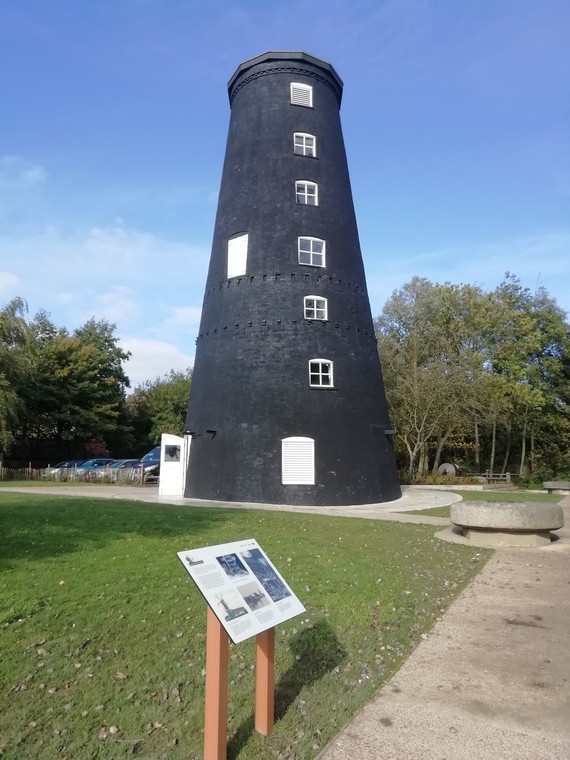 Hessle Whiting Mill is a unique example of an early 19th century whiting windmill.

After many months of waiting we are delighted to announce that May will see the opening of the foreshore's Hessle Whiting Mill. Fully refurbished and with original machinery and new displays on five levels, the mill will open to visitors on Tuesday 18th May and Friday 21st May between 10am and 4pm (closed 1 hour for lunch 12-1pm). The mill will open on these days and times each week thereafter.
Please be aware that only six visitors will be allowed inside the mill at any one time and face coverings are mandatory. Our project officer Alex and members of our wonderful volunteer team will be onsite to welcome you and answer any questions you may have. Once government restrictions are eased we will be able to increase the numbers permitted inside the mill and extended our schedule of open days.
We look forward to meeting you!
You can follow all the latest news and updates from Hessle Mill and Chalk Walk on our website: https://eastridingcoastandcountryside.co.uk/countryside/quarry-to-country-park/
or follow our Facebook page: https://m.facebook.com/HumberBridgeCP
|
By Sally George, Quarry to Country Park Volunteer
During 'lockdown' I was struggling to find local walks that were new to me. Whilst rummaging through O.S. maps I came across an 'Explorer Pack' of cards produced by Humberside County Council Technical Services Dept. Country side Group. These must have been produced around 1994 although I couldn't find an exact date. Humber Bridge Country Park was on one of the cards explaining that the park, although only 48 acres in area, was made up from 3 separate parts: Hessle Quarry, Little Switzerland and the old chalk-crushing windmill with a history going back to 1317 AD when a chalk quarry was already operating.
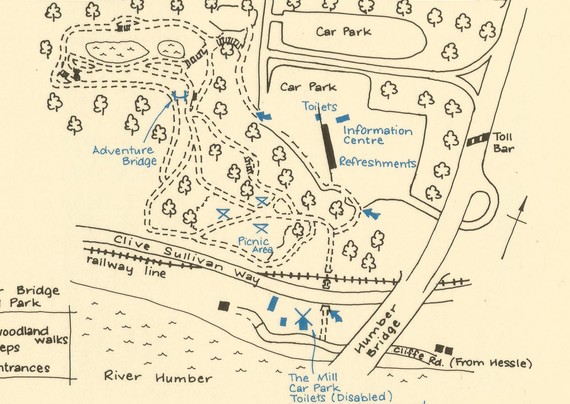 Map of the Country Park from the 1990s Explorer Pack.
 |
|
The plants in the quarry came in the soil which was used to fill the pits when digging moved on. Other seeds were carried on the wind from neighbouring gardens and passing trains. A major feature of the park are the buddleia bushes whose purple flowers are irresistible to butterflies. Crow garlic, the common spotted orchid, violet and celandine can also be seen in season.
Wildlife includes shrews, voles, frogs, newts and of course, their predators - kestrels and weasels. Other birds are the great tit, blue tit, bullfinch, goldcrest and warblers. Winter visitors such as redwing and fieldfare enjoy the berries which grow in such profusion.
From the map on the card, I shall enjoy a walk around the site to 'spot the changes' from 27 years ago.
|
The Hessle Quarry Strike of 1893, Part 2
By Dianne Smith, Quarry to Country Park Volunteer
Please see April's e-newsletter for part 1 of the article.
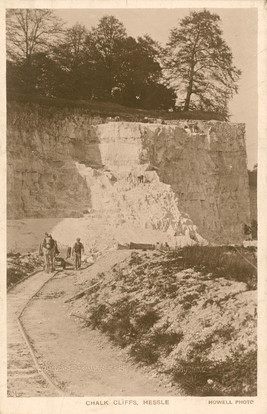
On the 26th September, the Eastern Morning News announced that “terms had been arranged between masters and men and that the masters had given way.” An angry John Hearfield condemned this as “misleading and untrue”. He went on to say that his quarries and mills were fully working and he had had “offers on all sides” for labour and was having to refuse men work. He added that the other quarry owners, Messrs Marshall and Hudson, had declined such offers as they did not want to “replace the old hands and so render them idle for the winter.”
By the 27th the talks were still in deadlock. Mr Cockayne, the Leeds delegate of the union, informed the employers that his men had refused their proposals and would continue the strike.
The employers then issued an ultimatum to the workers:
|
“We, the undersigned, being the masters of the chalk quarries and whiting mines at Hessle, give notice as an ultimatum to the men who have gone on strike, that up to Thursday night, the 28th inst., at six o’clock, we are prepared to receive the names of any men who may desire to commence work, and will consider each application and give work to all applicants, so far as the vacancies will admit, whom we approve of.”
This was signed by all three employers: Hearfield Bros., W. Marshall, C. J. Hudson.
The Hull Daily Mail reported on the 29th September that Hearfield’s and Marshall’s mills were in full work and Mr Hudson had one or two men working at his quarry. The dispute was still ongoing but by then some of the former strikers had returned to work and on the 4th October the York Herald announced that “the strike may be said to be over, the men, such of them as have been able to obtain situations – having returned to work on the conditions imposed by the employers.”
 Hessle Quarry labourers.
John Hearfield, at one point, states that he has more workers than he needs, so it would be interesting to know how many men got their old jobs back. It is difficult to tell now but toing and froing between the censuses can give some idea. Some of the families who had been at the Cliff for years were still working there in 1901: the Collinsons (William Collinson had been working in various quarries since the 1850s), the Robinsons (Warcup Robinson was foreman at the mill in 1891, 2 of his sons were still employed there in 1901), the Stathers (Alfred Stather was a quarry foreman from 1881-1911 and 3 of his sons were working there in 1901) and the Blooms (Richard Bloom was a quarryman in 1891 and also in 1901 and 2 of his sons were working there in 1901).
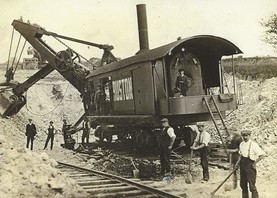
Of 25 other men employed in the quarries or whiting works in 1891 at least 15 were still employed in 1901. Several employed in 1891 had moved out of the village by 1901. The Branch Representative, William H Stokes, a blacksmith living at the Cliff had moved to Hull
by 1901. This, of course, is not a complete picture but an indication that, at least some, continued in their employment.
|
Picture Perfect
By Sally George, Quarry to Country Park Volunteer
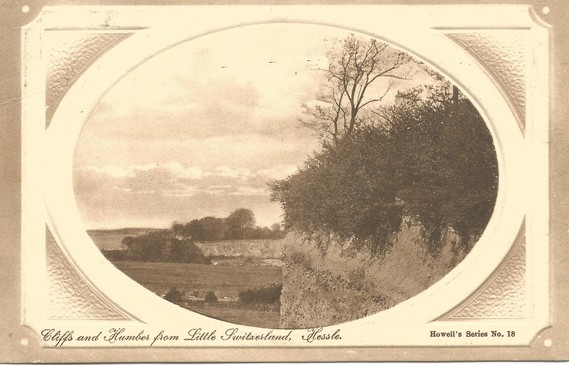 "Cliffs and Humber from Little Switzerland, Hessle"
The postcard, in sepia, is of the cliffs and Humber from Little Switzerland. Before 1918 the postage cost to send a postcard was a halfpenny so, posted in Hessle, from Dora to Miss Lily Mitchell, it must have been sent pre 1918. I was impressed at the minimal address "@ yellowstone", Ilkley. It took me a while to research this but I found Yellowstone as a large semi detached house at 70 Parish Ghyll Drive in Ilkley.
 From Dora to Miss Lily Mitchell "@ yellowstone".
It took me a while to research this but I found Yellowstone as a large semi detached house at 70 Parish Ghyll Drive in Ilkley. In a Leeds newspaper there are several 'Wanted Adverts' from 1908 to 1921 from a Mrs. Morley of Yellowstone who required a housemaid, cook, nursemaid aged about 20 for one baby, and a waitress, "kept liberal outings' and good refs essential". All this was for a family of four! One wonders which of these roles Miss Lily Mitchell was involved with. Dora writes to her friend "Dear Lily, Just a P.C. as per promise. We are having a good time, going to the sea for a few days. Hope you are well. Yours Dora.
Digging into the Past

This image (right) is of the 1931-built Ruston Bucyrus 25-RB which once worked in the chalk quarry. Otherwise known as a "Steam Navvy" and weighing 125 tons, it was one of the last steam-powered shovels to have been built by the company.
Following withdrawal from quarry service in the 1960's the excavator was initially purchased by a group of steam enthusiasts. By the early 1970's they transferred it to Beamish, the Living Museum of the North, where it was one of the earliest exhibits on site.
The transfer to Beamish was not without incident! The huge machine was semi-dismantled and transported, partly on one of the British Army's tank transporters and partly under its own steam. However, on arrival at the museum site, the machine crossed over softer ground and began to sink. Heavy tracked equipment had to be quickly deployed to prevent it from toppling over. It was eventually transferred onto the hard standing area where it remains today.
|
 The 1931-built Ruston Bucyrus 25-RB on display at Beamish Museum.
Meet the Team: Dianne
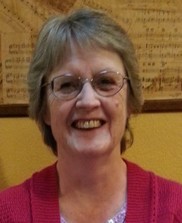
The walk from the Humber Bridge car park to the Mill is a really lovely walk and the Mill such an interesting place to explore. So when I heard that Alex (whom I had worked with in the Archives) needed people to steward at the Mill, I volunteered and was very impressed with what Alex had achieved.
Having a love of history I have volunteered at the Beverley Guildhall Museum and with the East Riding Archives’ WWI Lives project and online exhibition (a little plug here!) http://www.eastridingarchives.co.uk/WW1Lives and some years ago (actually many years ago) stewarded at the Beverley Friary. I’m also mad about Family History.
I look forward to be able to continue stewarding at Hessle Mill – I only managed one very cold, rainy session before lockdown. Good luck Alex.
|
From the Archives
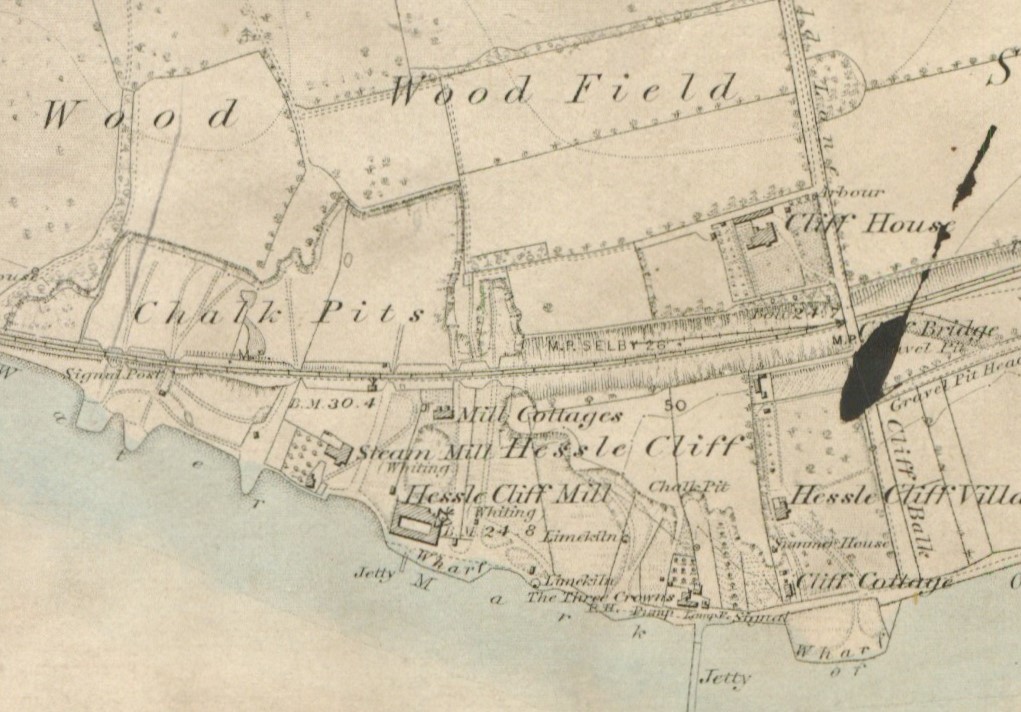 An Ordnance Survey Map from 1855 (Archive Ref: OS/1/239) showing the industry that once occupied the Country Park and foreshore.
This month's 'From the Archives' feature is an Ordnance Survey map published in 1855. The Ordnance Survey is generally considered to have originated between 1747 and 1755 when a military map of the Highlands of Scotland was produced following the campaign against the Jacobites. The first map to be published directly by the Ordnance Survey, in 1805, was of Essex. The Ordnance Survey Act 1841 is the basis of the modern department. It provided for the survey of Great Britain and the Isle of Man under the authority of the Board of Ordnance. By the year 1855, when the Industrial Revolution was well under way, the need for maps larger than the one-inch and six-inch scales was realised.
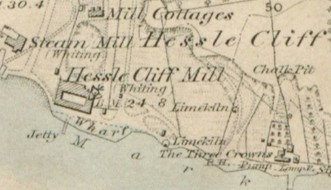
This particular 6 inch to 1 mile map, held within the collections of East Riding Archives (Archives Ref: OS/1/239), shows the area of what is now the Humber Bridge Country Park and Hessle foreshore. Last month's newsletter featured an enclosure map of the same area from 1794, by comparison you will notice how heavily industrialised the site had become in the space of 60 years. As you can see, infrastructure includes, the whiting windmill, a steam whiting mill, lime kilns and tramways leading from the quarry to the foreshore. Evidence of the nucleus of a small industrial community can also be seen, complete with labourer's cottages, a water pump, an Inn and gardens. The further industrial development of the area can be traced using subsequent OS maps up to the 1950s.
You can explore these and other digitised OS maps from East Riding Archives' collections at: https://treasurehousemaps.eastriding.gov.uk/
You can find out more about East Riding Archives at: https://www.eastridingarchives.co.uk/
|
East Riding Libraries and Customer Services
 East Riding Libraries and Customer Service sites reopened their doors to customers after operating an order and collect service during the last lockdown and are now conducting a survey to find out how residents view the service and what will meet the needs of the community in the future.
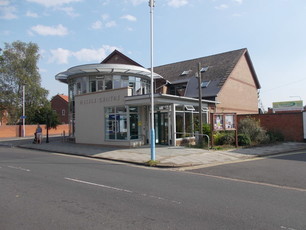
Libraries have long departed the traditional image of silent study spaces with stern librarians. Prior to the start of the pandemic, East Riding Libraries like the Hessle Centre were bustling community hubs, full of social and group activities including: Reminiscence for older people and those living with dementia; Bounce and Rhyme sessions for babies and toddlers with their parents and carers; knit and natter groups for crafters of all ages; coding clubs for children; and reading groups for all ages. All this alongside public access computers, free for all to use and popular with job hunters and students, and safe public working spaces used by tutored children and young people, local businesses and community projects.
|
The survey has been designed to find out what customers’ views are on the various services offered by East Riding Libraries, and see what has changed over the course of the pandemic. Customer feedback is essential to help shape the service moving forwards and provide the information, resources and support that the Library service can offer communities in the East Riding.
Here's a link to the survey: https://smartsurvey.co.uk/s/Library-pre-re-opening
The survey is available to complete from now until 30 May, 2021.
|